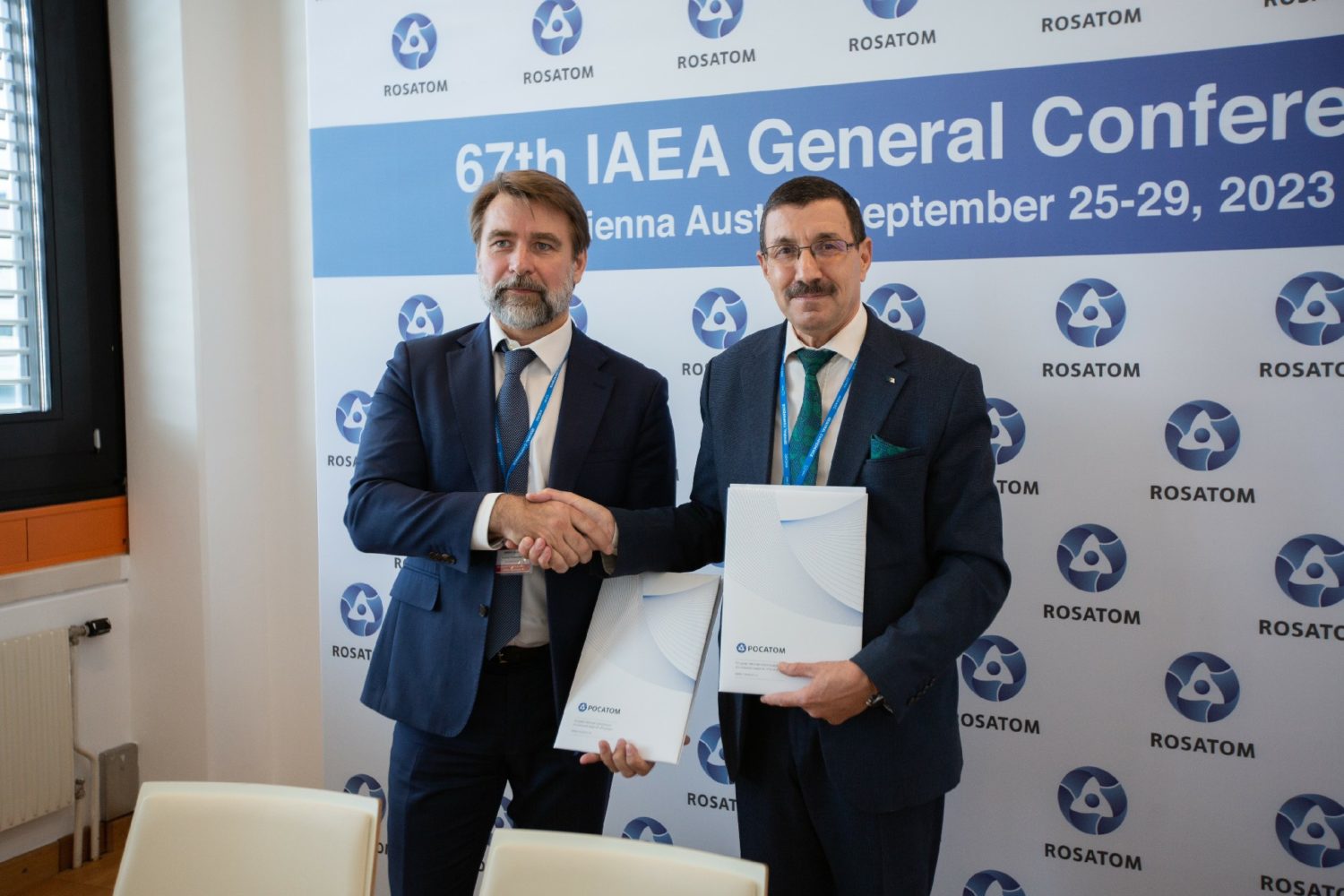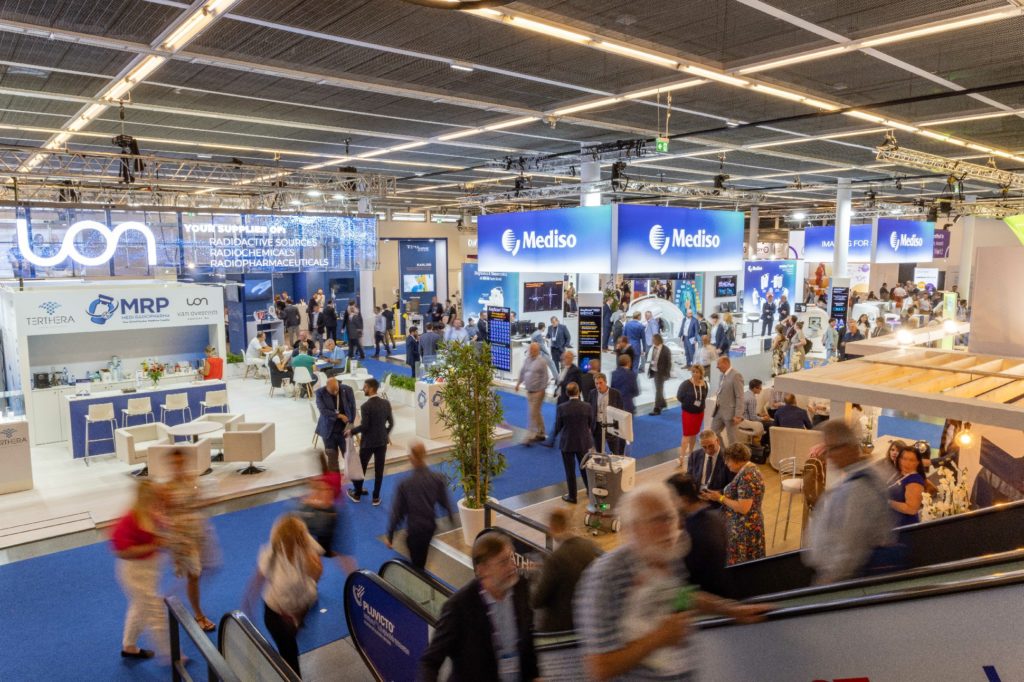
Fresh Glance at Radiopharma
back to contentsIzotop (part of Rosatom’s Healthcare Technology division) took part in the 36th Annual Congress of the European Association of Nuclear Medicine (EANM 2023). The company presented medical isotopes produced by the Russian nuclear corporation, one of the global market leaders.
About the congress
Held in Vienna on September 9–13, the EANM Congress was attended by over 7,000 nuclear medicine experts from more than a hundred countries. The key topics covered were advances in radiation diagnostics and therapy. In particular, the congress discussed the development of particle acceleration and cyclotron technology and the use of alpha-emitting radioactive nuclides (α-emitters) in nuclear medicine. These are the radionuclides preferred as radiopharmaceuticals at present.
Canada, Japan and some European countries put a premium on astatine‑211 as an alpha emitter. This is an element that is virtually uncommon in natural conditions — it was synthesized even before it was discovered. Most market participants, however, still consider actinium‑225 to be the most effective alpha emitter and therefore show keen interest in it. Currently, over 50 medical institutions around the world, including a number of clinics in Russia, are conducting research on actinium‑225. The only one in Russia, Rosatom is also a Top 3 global producer of actinium‑225. Since this isotope is produced in extremely small amounts, only a few hundred patients per year can receive treatment with actinium‑225 worldwide.
Lutetium‑177 is the most widely used beta emitter. It is highly effective in diagnostics and targeted therapy of a number of cancers, such as inoperable metastatic prostate cancer. Coincidentally, while the congress was running, the Russian regulator Rostechnadzor granted the Leningrad NPP (part of Rosatom) a permit to produce lutetium‑177 at two of its units at once, Units 3 and 4. The pilot batches of the radionuclide will be produced by the end of this year.
The congress also discussed the development of fundamentally new techniques, such as neutron capture, photon capture and others.
Rosatom’s contribution
Izotop’s booth at the congress featured information about Russian isotope products. It was also a venue for business meetings with existing partners and potential customers.
“The congress confirmed the high level of Rosatom’s competencies in isotope technology. We made agreements with our long-term partners to continue and expand cooperation. What is more, our delegation made new contracts for the supply of key isotope products,” Anton Shargin, Deputy CEO for Commercial Affairs at Izotop, commented on the results of the congress.
Earlier this year, Izotop made the first shipments of isotope products to Italy and gallium generators to Kazakhstan and India. Gallium‑68 is used in diagnostics of a wide range of cancers by PET scanning. Each year, over 100,000 diagnostic procedures are carried out with this radionuclide worldwide.
Izotop also won an international contract with Belarus to fully meet its needs for technetium‑99m generators, and the first deliveries have already been made.
In late September, Rosatom signed a memorandum of understanding with the Algerian Commission of Atomic Energy (COMENA). The parties will cooperate in carrying out medical projects and developing nuclear medicine.

Isotope mainstay
Rosatom operates two out of the world’s four largest production facilities for stable isotopes and at least 30 % of the reactor fleet involved in the commercial production of radioisotopes. In addition, the Russian nuclear corporation is building Europe’s largest radiopharmaceuticals factory. In 2025, when the factory is commissioned, its 21 process lines are expected to produce more than 25 different radiopharmaceuticals. The construction works on the factory site started in January and are going ahead of schedule. The cast-in-place concrete frame of the building is almost ready.
The first section of the factory will manufacture technetium‑99m generators for the production of diagnostic drugs for over 20 diseases, iodine‑131‑based drugs for the treatment of the thyroid gland and neuroblastoma in children, samarium‑153 to reduce pain syndrome and suppress metastasis to bone tissues in various cancers, and radium‑223 for the treatment of bone metastases in patients with castration-resistant prostate cancer. The factory will also produce new radiopharmaceuticals based on carrier-added and non-carrier-added lutetium‑177, actinium‑225, thorium‑227 and other isotopes for the treatment of inoperable metastatic forms of cancer.
Rosatom is also involved in the development of innovative radiopharmaceuticals. For example, a drug based on radium‑223 developed jointly by the Research Institute of Atomic Reactors (part of Rosatom) and the Federal Research and Clinical Center for Medical Radiology and Oncology has proved safe and effective during clinical trials in the treatment of bone metastases of prostate cancer. The drug is not inferior in quality to foreign counterparts but its price is lower. “If you take a look at the production chain of any radiopharmaceutical, you will see that Rosatom is present at its every link,” Izotop CEO Maxim Kushnarev noted earlier in an interview to the Novy Atomny Ekspert (New Nuclear Expert) magazine.




